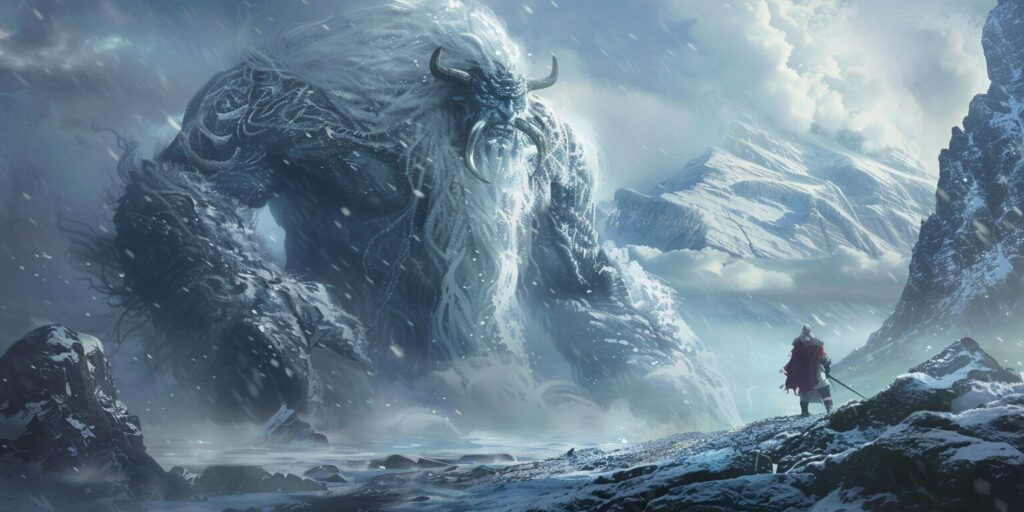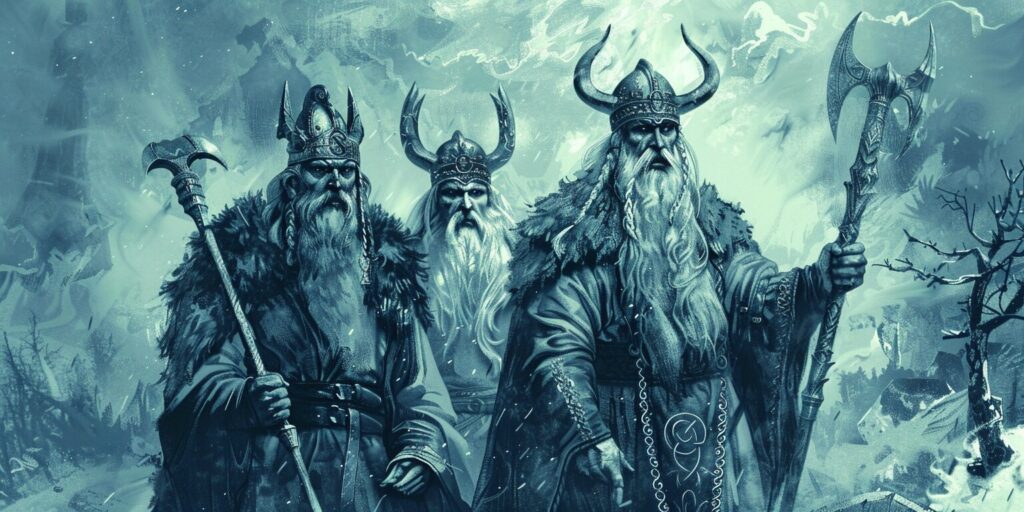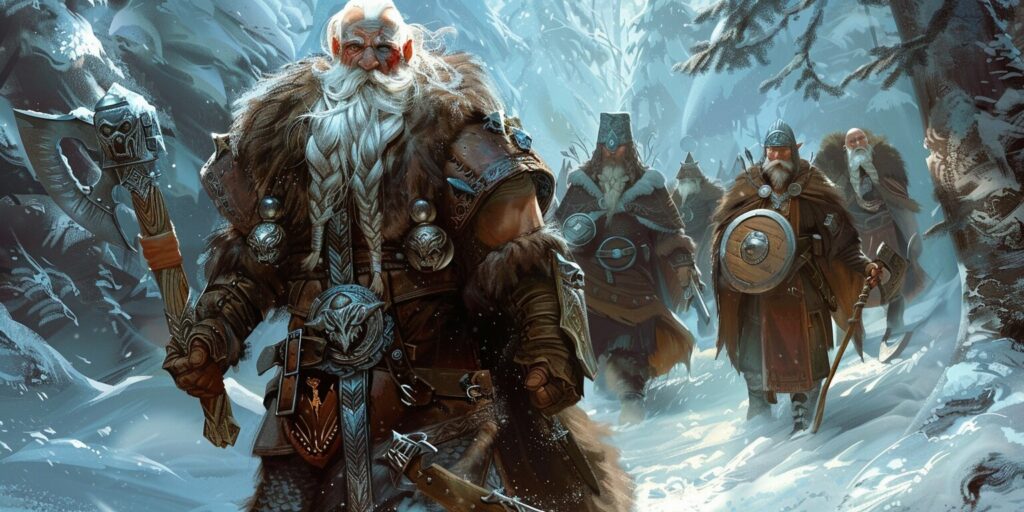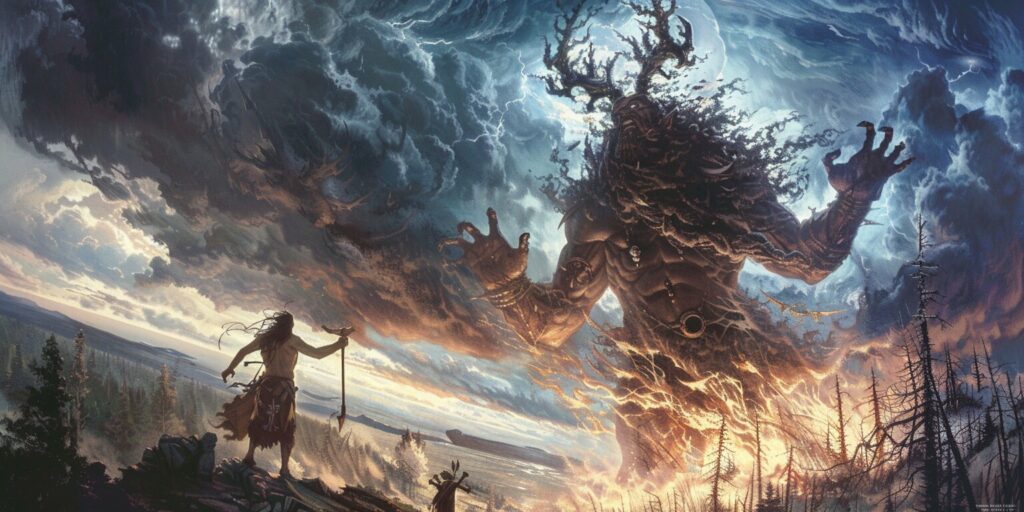Aesir Gods, Ask and Embla, Dwarves, Norse Cosmology, Norse Gods, Norse Mythology, Odin, Tales of the Gods, Vili and Ve, Ymir
From Ymir’s Body: The Norse Mythology of Earth’s Creation
In this article, we will explore the origins of Norse mythology and dive deep into the captivating Norse creation myth. We will unravel the tale of Ymir, the primordial giant whose existence kickstarted the birth of the cosmos. Along the way, we will uncover the intricate connection between Ymir and the legendary god Odin and the involvement of other divine beings in this cosmic drama.
Join us as we delve into how was the world created Norse mythology, exploring the significance of giants, the role of dwarves in the creation myths such as the crafting of Ask and Embla, and the divine intervention of the Aesir. By the end of our journey, you will gain a comprehensive understanding of the captivating Norse creation myth, including the emergence of Buri from the salty ice, licked into being by the cow Audhumla, and the influential characters like Bestla and Bor, who shaped the world we inhabit today.
Exploring the Origins of Norse Mythology
In this section, we will delve deeper into the origins of Norse mythology, specifically focusing on the Norse creation myth and the significance of the Prose Edda by Snorri Sturluson. Keep reading to find out how was earth created in Norse mythology.
Understanding the Norse Creation Myth
The Norse creation myth is a captivating tale that explains the origins of the world. Central to this myth is the primordial void known as Ginnungagap, which existed before the formation of the universe. From Ginnungagap, the realms of fire and ice emerged, giving birth to the worlds we know today. The creation of these worlds involved the slaying of the giant Ymir, whose body played a crucial role in the formation of Earth. This creation myth serves as the foundation of Norse cosmology and provides insights into the Norse understanding of the universe, including the first humans, Ask and Embla.
Delving into the Prose Edda by Snorri Sturluson
The Prose Edda, written by Snorri Sturluson, is a medieval text that offers invaluable insights into Norse mythology, including the creation myth. Sturluson’s work compiles various myths, legends, and poetic elements, providing a comprehensive understanding of Norse cosmology, gods, and heroes. It serves as a crucial source for scholars and enthusiasts seeking a deeper exploration of Norse mythology, shedding light on the origins and beliefs that shaped this rich and intricate tradition.
By examining the Norse creation myth and delving into the Prose Edda, we can better understand the origins of Norse mythology and the significance of these myths in shaping the Norse worldview.
Unraveling the Tale of Ymir in Norse Mythology
In Norse mythology, Ymir is recognized as the primordial frost giant, playing a significant role in the creation of the world. Ymir’s mythical presence and actions, rooted in the icy and salty origins of the Norse cosmos, are considered fundamental to the origin and development of both humans and giants in Norse cosmology.
Ymir: The Primordial Giant
According to Norse mythology, Ymir was born from the combination of the primordial elements of ice and fire within Ginnungagap, the cosmic void. Ymir is often described as a colossal being, embodying the chaos and potentiality that existed before the establishment of order in the cosmos.

Ymir’s body plays a crucial part in the world’s creation. It is said that various realms and beings emerged from his slain body. This includes the formation of Earth, known as Midgard, which was fashioned from Ymir’s flesh. Ymir’s bones became the mountains, his blood turned into the oceans, and his skull became the sky, encompassing the realm of humans.
Ymir’s Role in the Creation of the First Humans
Ymir’s significance in Norse mythology extends further to the creation of the first humans. According to mythological accounts, the gods Odin, Vili, and Vé used Ymir’s body as raw materials to shape humankind, sparking life into the first humans, Ask and Embla.
Odin and his brothers took Ymir’s lifeless body and skillfully imbued it with life and consciousness. Through their divine intervention, they instilled the spirit of humanity into the world by using Ymir’s physical remains, effectively establishing the first human ancestors.
The Significance of Giants in Norse Mythology
Giants are highly important in Norse mythology, and their existence is closely intertwined with the narrative of creation. In addition to Ymir, giants are depicted as significant figures who live in various realms and possess incredible strength and knowledge.
The giants represent a primal, unruly force that continually challenges the gods and the established order. They embody the power of chaos and the natural world, contrasting with the gods who symbolize civilization and order. The recurring clashes between gods and giants serve as a recurring theme in Norse mythology, reflecting the ongoing struggle between order and chaos.
Overall, the tale of Ymir in Norse mythology elucidates the complex relationships between giants, spawned from Ymir, humans, descended from Ask and Embla, and gods. It highlights the interdependencies and conflicts that shape the Norse cosmos, offering profound insights into the origin and nature of the world as perceived by the ancient Norse people, poetically rendered in the Poetic Edda.
Odin and His Brothers: The Architects of the Norse Realm
In Norse mythology, Odin, along with his brothers Vili and Vé, played a crucial role in the creation of the Norse realm. These mythical deities were instrumental in shaping the world as we know it.

The Mythical Deities – Odin, Vili, and Vé
Odin, known as the Allfather, was the ruler of the Aesir, the principal god in Norse mythology. He was associated with wisdom, war, and magic and was revered as the chief architect of the cosmos. Vili and Vé were his brothers and fellow deities.
Vili was characterized as possessing great strength and was often invoked for courage and protection. Vé, on the other hand, represented sacred spaces and sanctuaries, serving as a guardian of knowledge and divine mysteries.
Exploring the Connection Between Odin and Ymir in Norse Myth
One of the significant connections in Norse mythology lies in the relationship between Odin and Ymir, the primordial giant. According to myth, Odin and his brothers were responsible for slaying Ymir and using his body to create the world.
As the chief deity, Odin took a central role in this act of creation. By harnessing Ymir’s remains, Odin and his brothers brought order and structure to the chaotic void, laying the foundations for the Norse realm to come into existence.
This connection between Odin and Ymir shaped the creation myth and established Odin’s position as a powerful deity capable of orchestrating the formation of the universe.
Overall, Odin, Vili, and Vé’s role in creating the Norse realm is fundamental to understanding the mythology of the ancient Norse people. Their actions and contributions set the stage for the epic narratives and divine beings that populate Norse mythology, weaving a rich tapestry of cosmology and tales of heroism.
Creation of the World: A Cosmic Drama in Norse Lore
In Norse mythology, the creation of the world is depicted as a grand cosmic drama orchestrated by the divine beings known as the Aesir. These powerful gods play a crucial role in how was the universe created in Norse mythology and in giving birth to the realms that make up the universe.
The Divine Intervention of the Aesir in Creation
The Aesir, led by the chief deity Odin, are the central figures in the creation narrative. Through their divine intervention, they bring order to the chaotic void that existed before the world’s formation. Using their might and wisdom, the Aesir sculpt the physical and spiritual landscapes, ensuring that each element harmoniously interacts with the others.
The Aesir’s actions in creating the world highlight their immense power and responsibility as the guardians and caretakers of the Norse cosmos. They shape the land, sea, and sky and imbue the realms with life, laying the foundation for mortal beings and other mythical creatures inhabiting their world.
The Intricate Balance of Ice and Fire in the Norse Cosmos
The delicate balance between ice and fire is a notable aspect of the Norse cosmology. The realms of the Norse cosmos are believed to be a fusion of these opposing forces, with the icy lands of the giants juxtaposed against the fiery realms of the gods.
Ice and fire serve as physical elements within the Norse cosmos and as metaphysical representations of the cosmic duality and the eternal struggle between order and chaos. As the embodiments of order, the Aesir counterbalances the unpredictable and destructive forces of the giants, maintaining equilibrium in the Norse realms.
The Role of Dwarves in Crafting the Norse World
In addition to the divine intervention of the Aesir, the creation of the Norse world also involves the indispensable contributions of the dwarves. These skilled craftsmen, known for their exceptional talent in metallurgy and craftsmanship, play a vital role in shaping the physical aspects of the realms.

The dwarves forge powerful weapons and precious treasures for the Aesir, including Thor’s mighty hammer, Mjolnir, and Odin’s all-seeing spear, Gungnir. Their skillful craftsmanship, emblematic of dwarves like those who sparked life into the inert forms of Ask and Embla, not only enhances the aesthetics of the Norse cosmos but also strengthens the gods and reinforces their ability to protect and maintain order in the realms.
The role of dwarves in crafting the Norse world highlights their significance as creators and custodians of the physical realm, including their part in the story of Ask and Embla. Their craftsmanship is instrumental in ensuring that the realms possess both beauty and strength, underscoring their importance in the overall fabric of Norse mythology.
Overall, the creation of the world in Norse mythology is a captivating story, filled with divine intervention, elemental balance marked by frost and fire, and the contributions of various mythological beings, including the emergence of Buri and the creation of Bestla and Bor. Through the efforts of the Aesir and the craftsmanship of the dwarves, the Norse cosmos comes to life, serving as a backdrop for the captivating tales and adventures that unfold within its realms.
Summary
In Norse mythology, the creation of the Earth is intricately woven into a rich tapestry of gods, giants, and cosmic forces. At the center of this creation myth is Ymir, the primordial giant whose body becomes the foundation of the world. Ymir’s slaying by the gods Odin, Vili, and Vé sets the realms’ formation in motion.
Odin, the Allfather, plays a pivotal role in shaping the Norse cosmos. By using Ymir’s body to fashion the Earth, Odin, and his brothers establish the groundwork for the existence of humans, who are created from the remains of Ymir’s flesh and bones. The creation of the world is not simply a divine act but a cosmic drama involving the delicate balance of ice and fire, represented by the realms of Niflheim and Muspelheim.
The Aesir, the pantheon of gods in Norse mythology, further contributes to the intricate weave of the creation myth, including the story of how Ask and Embla were given life. Through their divine intervention, sparked by the encounter with Buri’s lineage, the Aesir shaped the world, ensuring the existence of order amidst the chaos. Beyond the gods, dwarves also play a crucial role in the formation of the Norse world. Gifted craftsmen, the dwarves use Ymir’s body and the elements around them to forge the mountains, seas, and celestial bodies.
By delving into the Norse mythology of Earth’s creation, we gain a deeper understanding of the intricacies and symbolism that shape this ancient belief system. From the mythic figure of Ymir to the actions of Odin and the Aesir, Norse mythology offers a rich tapestry of creation, intertwining divine intervention, cosmic forces, and the craftsmanship of both gods and dwarves.

